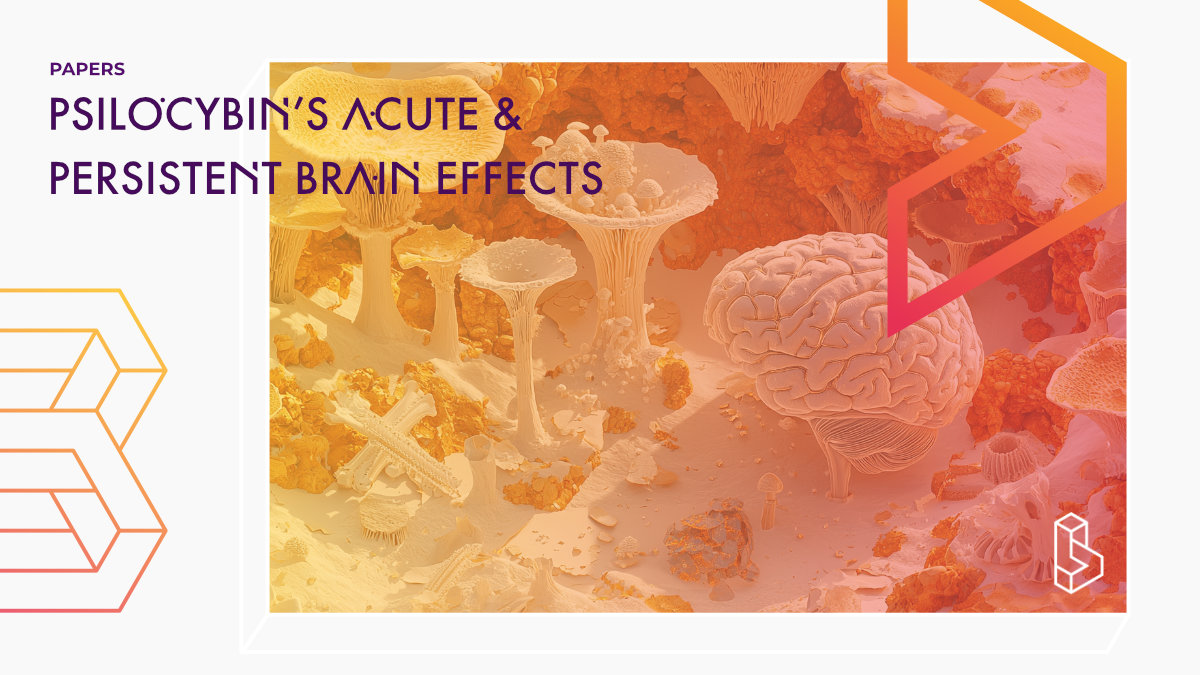This randomised cross-over study (n=7) used precision functional mapping with high-resolution multi-echo fMRI to characterise psilocybin (25mg) versus methylphenidate effects on brain networks, revealing decreased network modularity during psilocybin exposure and reproducible network changes. Participants showed unique brain configurations and reported stronger mystical experiences with psilocybin compared to methylphenidate.
Abstract of Psilocybin’s acute and persistent brain effects
“Psilocybin (PSIL) is a psychedelic drug and a promising experimental therapeutic for many psychiatric conditions. Precision functional mapping (PFM) combines densely repeated resting state fMRI sampling and individual-specific network mapping to improve signal-to-noise ratio (SNR) and effect size in brain imaging research. We present a randomized cross-over study in which PFM was used to characterize acute and persistent effects of psilocybin or methylphenidate (MTP) on brain networks. Seven healthy volunteers (mean age 34.1 years, SD = 9.8; n = 3 females, n = 6 Caucasians) underwent (1) extensive baseline imaging, (2) imaging beginning 60–90 minutes after drug exposure, and (3) longitudinal imaging for up to two weeks after drug exposure. Four individuals also participated in an open-label PSIL replication protocol over 6 months later. This dataset includes resting state (using advanced high-resolution multi-echo fMRI), task fMRI, structural, and diffusion basis spectral imaging as well as assessments of subjective experience. We are releasing this unique dataset as a resource for neuroscientists to study the acute and persistent effects of PSIL and MTP on brain networks.“
Authors: Subha Subramanian, Travis Rick Renau, Demetrius Perry, Ravi Chacko, Timothy O. Laumann, Karin Flavin, Christine Horan, Julie Schweiger, Nicholas Metcalf, Eric J. Lenze, Abraham Z. Snyder, Nico U. F. Dosenbach, Ginger Nicol & Joshua S. Siegel
Summary of Psilocybin’s acute and persistent brain effects
Psilocybin (PSIL), a serotonergic psychedelic compound, is being explored as a therapeutic agent for various psychiatric conditions, including depression, end-of-life anxiety, obsessive-compulsive disorder, eating disorders, and alcohol use disorder. The observed benefits often appear rapidly and may persist for weeks or months after a single dose. However, the mechanisms underlying these effects, especially their persistence, are not fully understood. While prior studies have emphasised the subjective, mystical experiences induced during the acute phase of psychedelic treatment, understanding the brain’s functional changes is essential for explaining long-term therapeutic outcomes.
Functional magnetic resonance imaging (fMRI) has been instrumental in examining how psychedelics affect brain connectivity. Previous research has reported reduced connectivity within the brain’s default mode network (DMN) and an overall reduction in brain-wide signal strength during the acute phase of psychedelic experiences. However, these studies have been limited by technical and methodological issues, such as inter-individual variability, head motion, and neurovascular confounds.
To address these limitations, the authors designed a “precision imaging drug trial” (PIDT), which applies precision functional mapping (PFM) techniques. PFM involves densely sampled, repeated MRI sessions and individualised brain network mapping to enhance data reliability. The study aimed to evaluate both immediate and lasting brain changes induced by psilocybin, compared to methylphenidate (MTP), an active placebo.
Methods
Study Design and Rationale
Find this paper
Psilocybin’s acute and persistent brain effects: a precision imaging drug trial
https://doi.org/10.1038/s41597-025-05189-0
Open Access | Google Scholar | Backup | 🕊
Cite this paper (APA)
Subramanian, S., Renau, T. R., Perry, D., Chacko, R., Laumann, T. O., Flavin, K., ... & Siegel, J. S. (2025). Psilocybin’s acute and persistent brain effects: a precision imaging drug trial. Scientific Data, 12(1), 1-12.
Study details
Compounds studied
Psilocybin
Placebo
Topics studied
Neuroscience
Healthy Subjects
Study characteristics
Original
Placebo-Controlled
Active Placebo
Double-Blind
Open-Label
Longitudinal
Within-Subject
Randomized
Bio/Neuro
Participants
7
Humans
Compound Details
The psychedelics given at which dose and how many times
Psilocybin 25 mg | 1x Placebo 40 mg | 1xLinked Clinical Trial
Precision Functional Brain Mapping in PsilocybinThis project will employ functional brain imaging to study the mechanism and immediate and long-term effects of psilocybin, a serotonin receptor 2A agonist, on cortical and cortico-subcortical brain networks in healthy adults.

